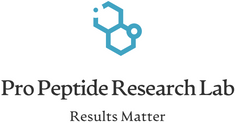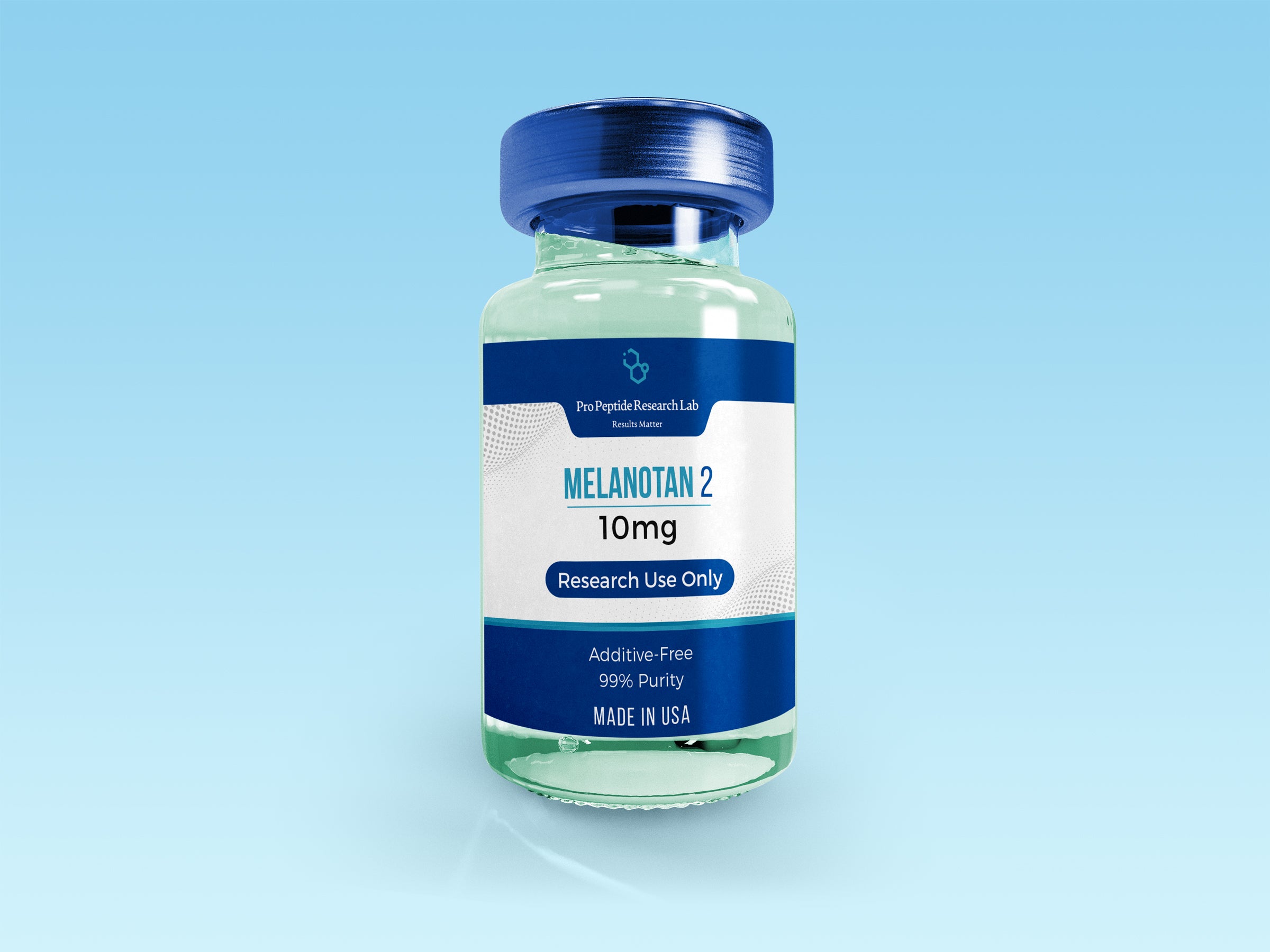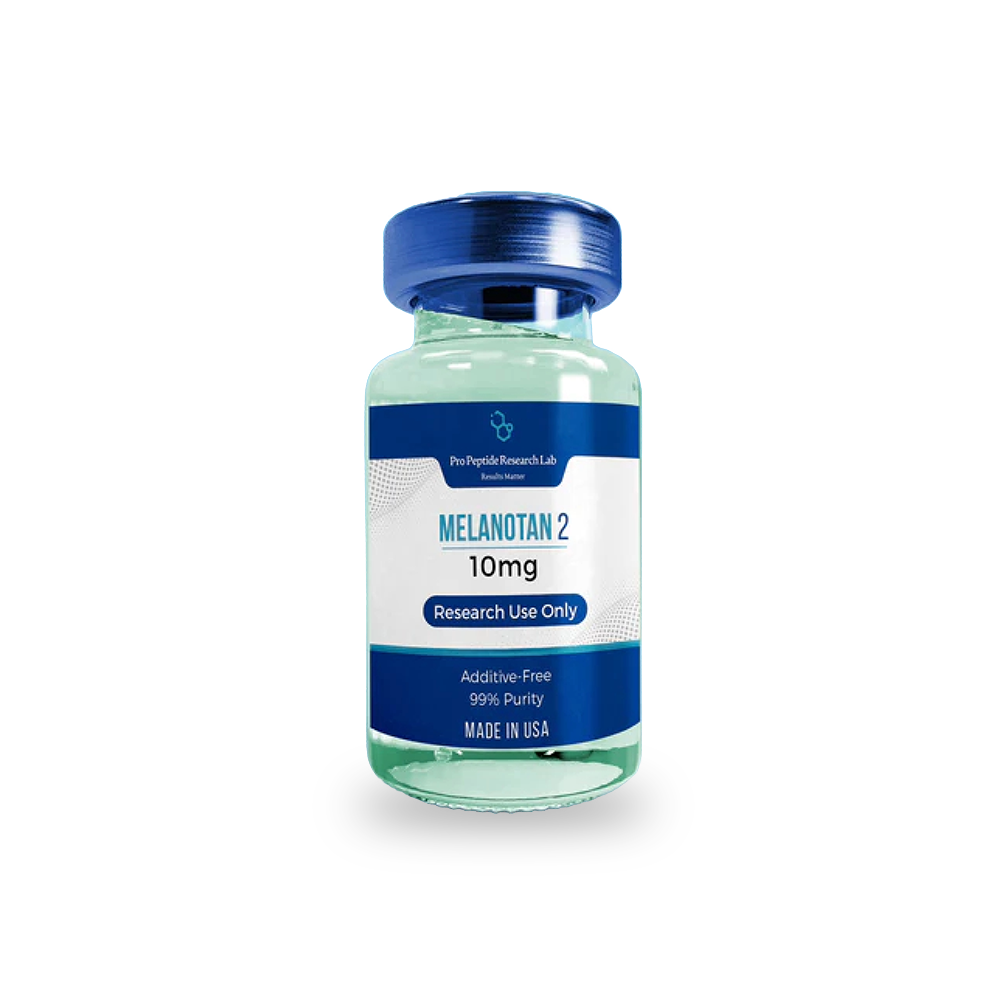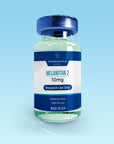
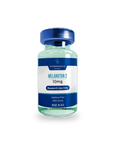
Melanotan 2 10mg
Melanotan 2 (MT2) is a synthetic analog of a hormone called alpha-melanocyte-stimulating hormone (α-MSH). It was developed as a potential treatment for certain skin conditions and as a tanning agent. During the testing of MT2 as a tanning agent, researchers uncovered a variety of other potential applications of this peptide. MT2 has since been investigated for its ability to increase arousal, decrease compulsive behavior, alter addiction patterns, fight hunger, reduce the production of glucagon, and even reverse certain features of autism. Melanotan 2’s cost of production makes it a very attractive option for research in these and other conditions.
What is Melanotan 2?
Melanotan 2 has a somewhat complex history of development that can be traced back to a peptide hormone called alpha-melanocyte-stimulating hormone. Alpha-melanocyte-stimulating hormone (α-MSH) is a peptide hormone that is naturally produced in the body. It is derived from the precursor molecule pro-opiomelanocortin (POMC) and is primarily produced in the intermediate lobe of the pituitary gland.
National Library of Medicine
The processing of POMC in the various natural melanocortins.
Source: National Library of Medicine
URL: https://www.ncbi.nlm.nih.gov/pmc/articles/PMC4312383/
The main role of α-MSH is to regulate the production and distribution of the pigment melanin, which is responsible for determining the color of our skin, hair, and eyes. α-MSH stimulates the melanocytes, which are specialized cells in the skin that produce melanin. By binding melanocortin receptors on melanocytes, α-MSH triggers a series of cellular processes that lead to increased production and dispersion of melanin, resulting in skin darkening or tanning.
In addition to its role in pigmentation, α-MSH has also been found to have various other biological effects. It has been implicated in regulating appetite and energy balance, modulating the immune response, influencing behavior and arousal, and potentially playing a role in anti-inflammatory processes.
Melanotan refers to a class of synthetic peptides that mimic the effects of the naturally occurring hormone alpha-melanocyte-stimulating hormone (α-MSH). The most well-known and widely discussed peptide in this class is Melanotan 2 (MT2). That said, before MT2 there was MT1 or, originally, Melanotan. MT-1 was the first synthetic analog of alpha-melanocyte-stimulating hormone (α-MSH) developed and has been studied for various clinical applications.
One of the primary clinical uses of MT- is in the treatment of erythropoietic protoporphyria (EPP), a genetic disorder that leads to an abnormal sensitivity to sunlight. In individuals with EPP, exposure to sunlight can cause severe skin reactions. MT1 has been found to help prevent or reduce the phototoxicity associated with EPP by inducing melanin production and providing some level of protection against harmful UV radiation. This is not curative but does decrease symptoms to a significant degree.
In addition to its role in EPP, MT1 has been investigated for its potential effects on other physiological processes. Some studies have explored its influence on blood pressure regulation, arousal, feeding behavior, and central nervous system function. However, it's important to note that the evidence regarding these effects is limited, and further research is needed to fully understand the potential benefits and risks.
MT1 is in Phase 3 trials for the treatment of polymorphous light eruption (PMLE), a common condition characterized by an itchy rash or hives that occur after sun exposure. It is also in Phase 2 trials for the treatment of actinic keratosis and squamous cell carcinoma, which are skin conditions associated with sun damage.
MT1 was very similar in structure to α-MSH. It only differs from α-MSH by a single amino acid. This makes MT1 useful as a substitute for α-MSH, but it also means that all of the myriad effects of α-MSH remain intact. Though this may be desirable in some conditions, it is also often desirable to reduce the total number of effects to focus on just one or two. This allows scientists to target a single physiological process without off-target effects. This can become especially important if the compound in question is being used to explore potential therapeutic ends. In general, it is useful for therapeutics to do just one thing and not have a lot of off-target effects because off-target effects can limit the long-term use of a compound and be considered side effects.
To overcome the wide range of effects that MT1 has, scientists began developing derivatives of it. One of those derivatives was MT2. MT2 is just 6 amino acids in length compared to MT1 at 13. This may not seem like a huge difference, but in the world of peptides, even a single amino acid added or subtracted can lead to huge changes. Such is the case with MT2.
How Does MT2 Work?
is a melanocortin receptor agonist, so understanding how it works requires some degree of understanding of the melanocortin system. The melanocortin system is a complex network of peptides, receptors, and associated molecules involved in various physiological processes. It plays a crucial role in regulating a range of functions, including pigmentation, energy balance, inflammation, immune response, arousal behavior, and stress responses.
The key peptides within the melanocortin system are alpha-melanocyte-stimulating hormone (α-MSH) and adrenocorticotropic hormone (ACTH), which are derived from the precursor molecule pro-opiomelanocortin (POMC). These peptides interact with specific melanocortin receptors (MC receptors) located throughout the body.
The melanocortin receptors are a family of G protein-coupled receptors, of which there are five subtypes: MC1R, MC2R, MC3R, MC4R, and MC5R. These receptors have different tissue distribution patterns and respond to the binding of α-MSH and ACTH with varying affinities. The MC1R is primarily involved in regulating pigmentation by stimulating the production and dispersion of melanin in melanocytes.
Apart from its role in pigmentation, the melanocortin system, specifically the MC3R and MC4R subtypes, is also involved in regulating energy balance and appetite. Activation of MC4R, for example, is known to promote satiety and reduce food intake, while impaired function of this receptor can contribute to obesity.
Melanotan 2 produces most of its effects through strong binding at the MC1R and MC4R with some weaker binding at MC3R. The binding at MC1R accounts for its impact on skin pigmentation while its binding at MC4R accounts for the role of MT2 in feeding behavior, addiction, and energy homeostasis. Binding to MC3R, even weakly, alters appetite and energy regulation as well, thus enhancing some of the properties of MC4R.
Knowing which melanocortin receptors MT2 binds to is only part of the journey toward understanding its effects. The next part of the journey is to understand where those specific receptors are located because a receptor in one region of the body will have very different effects than a receptor in another region. Melanocortin receptors (MC receptors) are found in various tissues throughout the body. Here is a general overview of their distribution:
- MC1R: MC1R is primarily expressed in melanocytes, which are pigment-producing cells in the skin, hair follicles, and eyes. Activation of MC1R by alpha-melanocyte-stimulating hormone (α-MSH) stimulates the production and dispersion of melanin, leading to skin and hair pigmentation[1].
- MC2R: MC2R is mainly found in the adrenal glands, specifically in the outer layer called the adrenal cortex. It plays a critical role in the production and release of cortisol, a hormone involved in stress responses and various metabolic functions.
- MC3R: MC3R is widely distributed in the central nervous system, including areas involved in appetite regulation and energy balance, such as the hypothalamus. It is also found in peripheral tissues, including the gastrointestinal tract and adipose tissue.
- MC4R: MC4R is predominantly expressed in the brain, particularly in regions associated with appetite control, such as the hypothalamus. It plays a crucial role in regulating food intake and energy expenditure. Mutations in the MC4R gene are associated with genetic forms of obesity.
- MC5R: MC5R has a more diverse expression pattern and is found in various tissues, including the skin, hair follicles, immune cells, and exocrine glands. Its specific functions are still being investigated.
Note that the MC1R is almost exclusively a pigment receptor and is found on cells where pigmentation is known to be important, including the eyes. To avoid the sunless tanning properties of melanocortins, avoiding binding to this receptor would be key. Though MT2 binds to MC1R with less affinity than MT1 or α-MSH, it does still bind and so creates some degree of skin pigmentation.
The MC3R is widely found in the central nervous system along with MC4R. These two receptors are likely to be of increased interest moving forward as they are most likely to regulate melanocortin effects on things like behavior. Understanding exactly how these receptors work and how they can be precisely targeted is one of the major goals of Melanotan 2 and other melanocortin research.
What Is Melanotan 2 Used for Behavior Research
The impact of MT2 on behavior is interesting because several studies have uncovered what seem to be disparate effects. This section covers the role of MT2 in conditions like autism, but also feeding behavior and arousal.
MT2 and Autism
One study conducted using a mouse model of maternal immune activation-induced ASD (a mouse model of autism), suggests that administration of MT-2 may reverse certain ASD features. This effect is proposed to be mediated by the stimulation of oxytocin release, as MT-2 is known to promote oxytocin signaling.
Oxytocin, often referred to as the "love hormone" or "bonding hormone," has been implicated in social bonding, trust, and emotional regulation. It has been explored as a potential therapeutic target for ASD due to its involvement in social behavior. Previous studies have indicated that oxytocin therapy may help mitigate some behavioral problems associated with ASD.
The findings from the mouse model of ASD suggest that MT-2 administration increased the expression of oxytocin receptors in specific brain regions, potentially contributing to the reversal of ASD-associated behaviors such as impaired social interaction, decreased communication, and repetitive behaviors[2].
In animal studies, oxytocin has been shown to play a significant role in maternal bonding and recognition of offspring through olfactory learning. Oxytocin appears to facilitate associative learning of maternal odor in young rats, and oxytocin antagonists can block this conditioning. It has also been observed that oxytocin administration can induce maternal behavior in adult rats by blunting olfactory processing, overcoming the natural avoidance of neonates.
In mice, oxytocin receptor activation in the medial nucleus of the amygdala is necessary for social recognition, and oxytocin receptor knockout mice exhibit deficits in social discrimination and increased aggressive behavior. However, administering oxytocin can restore social exploration, and social recognition, and reduce aggression in these knockout mice.
In humans, intranasal administration of oxytocin has been associated with various effects on social cognition. These include improvements in mental state inference ability, increased eye gaze towards neutral faces, enhancements in recognition memory for faces, and alterations in the processing of emotional facial expressions. Oxytocin has also been found to influence prosocial behaviors, such as increased adjacent lying and decreased anogenital sniffing in rats, as well as increased social approach activities in specific mouse strains with deficits in sociability.
Studies in prairie voles have demonstrated that oxytocin and dopamine play important roles in promoting partner preference formation, which represents a lasting social bond between mates. In this context, the researchers investigated the effects of MC receptor activation on partner preference formation in prairie voles and examined the potential interaction between the MC and OT systems during this process.
Peripheral administration of Melanotan 2, a brain-penetrant MC3/4R receptor peptide agonist, and Pf-446687, a highly selective small-molecule MC4R agonist, enhanced partner preference formation specifically in prairie voles but not in the non-monogamous meadow voles. Moreover, the partner preferences induced by MT2 were enduring, persisting even one week after the drug administration.
The study suggests that the prosocial effects of MC receptor agonists may be mediated, at least in part, through the modulation of oxytocin. This is supported by the finding that coadministration of an OT receptor antagonist prevented MTII-induced partner preferences in prairie voles. Additionally, MT2 selectively activated hypothalamic OT neurons and potentiated central OT release, indicating a potential mechanism through which MC receptor activation influences the OT system.
Given that oxytocin has been implicated in enhancing certain aspects of social cognition in humans, these findings suggest that the MC4R could be a promising therapeutic target for improving social functioning in psychiatric disorders such as autism spectrum disorders and schizophrenia. Activation of the MC4R, potentially leading to increased oxytocin release, may offer a pathway to modulate social behaviors and social cognition in these conditions.
In this study of rats, Group I served as the control and received only PBS (phosphate-buffered saline) for 30 days. Group II was the autistic model group and was treated with 250 mg PPA to model a neurological insult that might lead to autism. Groups III-VI were intervention groups: They were also given PPA injections but received either bee pollen, Lactobacillus paracaseii, a mixture of probiotics (MPB) called Protexin®, or stool transplantation from normal animals (FT) for 27 days before PPA neurotoxicity induction on the last 3 days of the study.
The results of the study indicated that the brain levels of the four neuropeptides (α-MSH, β-End, NT, and SP) were significantly reduced in the PPA-treated animals compared to the healthy control animals. In other words, neurologic injury that can lead to autism results in a deficit of several neurochemicals, some of which are known to be major actors in the melanocortin system. Administration of bee pollen as a prebiotic and the use of pure or mixed probiotics showed ameliorative effects on the neuropeptide levels. The findings suggest that bee pollen and probiotics have protective effects against the neurotoxic effects of PPA and that these effects may be mediated through the melanocortin system to some extent.
In summary, the melanocortin system appears to play at least some role in the neurological processes that lead to autism, most likely by regulating the oxytocin system. Research has indicated that some melanocortin receptor agonists, like MT2, could potentially be used to mitigate or even prevent the neurological processes that lead to autism. A great deal more research is needed, but the path forward is clear and holds promise.
MT2 and Impulse Control
Research suggests that MT2 (Melanotan-2) may have an impact on impulse control and alcohol intake. Studies conducted in rats have shown that MT2 administration can reduce alcohol intake and increase water intake, even in rats that prefer alcohol. This indicates a potential role for MT2 in modulating alcohol consumption behaviors.
Furthermore, recent research has demonstrated that MT2 works synergistically with naltrexone, a medication used to treat alcohol dependence, to reduce binge-like ethanol intake in mice. The combination of MT2 and naltrexone was found to be more effective in blunting excessive alcohol consumption than either treatment alone.
The link between alcohol and the melanocortin system was furthered in 2017 by another research study that suggests that alcohol consumption can lead to a decrease in levels of α-MSH (alpha-melanocyte-stimulating hormone), a key component of the melanocortin system. This decrease in α-MSH levels may then trigger a series of inflammatory pathways in glial cells, a type of supportive cells in the brain.
The inflammatory response in glial cells, particularly in the ventral tegmental area (VTA) and nucleus accumbens (NAc), two brain regions involved in reward and addiction, can result in altered communication between glial cells and neurons, referred to as gliotransmission. These changes in gliotransmission may ultimately contribute to increased dopamine signaling in the NAc, a key neurotransmitter implicated in reward and addiction.
The proposed mechanism suggests that the alcohol-induced disruption of the melanocortin system and subsequent glial inflammation could enhance the vulnerability to alcohol dependence and addiction, particularly during adolescence and adulthood when the brain is still developing and more susceptible to the effects of alcohol. This may explain why, in the earlier study, MT2 mitigated the effects of alcohol addiction/impulse behavior. By replacing some of the lost α-MSH, MT2 would help to restore the function of the melanocortin system and prevent the cascade that leads to altered gliotransmission from occurring.
MT2 and Food Intake
The specific case in which MT2 appears to mitigate some addictive behavior as it relates to alcohol may have broader application. Research suggests that activation of the central melanocortin system by MT2 can suppress eating behavior. Research in mice shows that zmZT2 is a potent appetite suppressor and can rapidly reduce body mass. The question, of course, is why.
New research highlights a new neuropeptide called melanin-concentrating hormone (MCH) and identifies it as a key player in promoting both food intake and energy conservation, ultimately contributing to body weight gain. MCH is produced in specific regions of the brain, namely the lateral hypothalamic area and the adjacent intra-hypothalamic area. Decades of research have shed light on the neural pathways and mechanisms through which MCH stimulates food intake. Recent advancements in technology have allowed for selective manipulation of MCH neuron activity, uncovering novel insights into the hyperphagic effects of MCH.
One such mechanism involves neural "volume" transmission in the cerebrospinal fluid, which represents a unique mode of communication between MCH neurons and their target areas. It also seems that MCH interacts with other peptide systems, like leptin, highlighting the intricate network of signaling pathways involved in food intake regulation. Understanding these interactions and their impact on energy balance can provide valuable insights into the development of potential therapeutic approaches for managing obesity.
This interaction between melanocortins and leptin should come as no surprise to anyone in the field because previous research has shown that central MC4R blockade abolishes central nervous system control of leptin over food intake. For years, scientists have known that leptin promotes satiety, but they have not understood the mechanism by which it achieves this feat. Supplementation with leptin has shown little to no efficacy in curbing hunger and scientists have been frustrated by what seems like a promising means of controlling hunger and overcoming the obesity epidemic.
As it turns out, MC4R and leptin work together to regulate hunger signals. Alone, neither peptide can fully account for the effects of the team and leptin appears to be the weaker of the two players when left to its own devices. Research in mice shows that MC4R mediates much of the anorexigenic effects of leptin and also has antidiabetic and beneficial cardiovascular effects as well[10].
Other research in hamsters shows that MT2 can attenuate the effects of both ghrelin and food deprivation. Ghrelin and agouti-related protein (AgRP) mediate the effects of food deprivation on foraging behavior and food hoarding in many species, including the hamsters used in this research. Food deprivation leads to increased production and release of ghrelin and AgRP, which subsequently stimulate food intake and hoarding behavior.
The researchers aimed to investigate whether activation of the melanocortin 3 or 4 receptors, which are targeted by AgRP as an inverse agonist, could modulate the effects of food deprivation or ghrelin on foraging, food hoarding, and food intake. They used Melanotan 2 and administered it into the 3rd ventricle of hamsters subjected to different feeding conditions and housed in a running wheel-based food delivery foraging system.
The results showed that food deprivation had a stronger impact on foraging and hoarding compared to ghrelin administration. Concurrent injections of MT2 completely blocked the effects of food deprivation and ghrelin on food intake and attenuated, but not completely abolished, the effects of food hoarding. This suggests that MC3/4R activation is involved in mediating the increased food intake induced by ghrelin and food deprivation. However, other neurochemical systems, such as neuropeptide Y, may also play a role in regulating food hoarding and foraging behavior.
Furthermore, neuropeptides such as neuropeptide Y (NPY) and cocaine and amphetamine-regulated transcript (CART) may be involved in the regulation of the actions of serotonin agonists. The precise mechanisms underlying the interactions between serotonin, melanocortins, and other neuropeptides are complex and require further investigation. What is clear, however, is the importance of downstream activation of melanocortin receptors in mediating the hyperphagic effects of serotonin, suggesting, once again, that melanocortin receptors might make good therapeutic targets for manipulating feeding behavior in avian species.
One final note on MT and food intake is that some research indicates that the melanocortin system may have different levels of sensitivity to different types of food. In one study of rats, researchers found that those fed a high-fat diet responded to an MT2 administration to a much greater degree than those fed either regular diets or those that were high in sugar. These findings suggest that control of eating behavior may be nuanced, with different systems of different components within a given system having differential impacts on appetite for specific food items. If this is true, then it might be possible to one day fine-tune not just calorie intake, but specific food choices.
Melanotan 2 and Joint Health
Research has recently identified some musculoskeletal effects of melanocortins that are completely unrelated to the central melanocortin system. One study found that pro-opiomelanocortin (POMC)-derived peptides, specifically β-endorphin (β-ED) and α-melanocyte-stimulating hormone (α-MSH), are present in the synovial fluid of patients with rheumatoid arthritis (RA), osteoarthritis (OA), and juvenile chronic arthritis. Additionally, α-MSH concentrations were higher in patients with more severe polyarticular/systemic-onset juvenile chronic arthritis.
Research has also shown that α-MSH levels in synovial fluid exhibit a negative correlation with disease severity in patients with posttraumatic ankle osteoarthritis (PTAOA), as indicated by Mankin scores, degradation biomarkers (CTX-II and AGG-1), and inflammation markers (IL-6 and matrix metalloproteinase-3, or MMP-3). In other words, melanocortins appear to slow disease progression in osteoarthritis.
It has been observed that POMC peptides detected in synovial fluid may originate from the systemic circulation or non-fibroblast cell types within the synovial membrane, such as macrophages or endothelial cells. Synovial fibroblasts from OA patients do not synthesize POMC protein. Interestingly, various cell types within the synovium express receptors for POMC-derived peptides. Specifically, in OA synovial fibroblasts, the melanocortin 1 receptor (MC1R) has been identified as the receptor for α-MSH and related peptides.
National Library of Medicine
Source: National Library of Medicine
URL: https://www.ncbi.nlm.nih.gov/pmc/articles/PMC5855589/
So, this research is essentially telling us that melanocortins may play a role in modulating inflammation in the musculoskeletal system. Compared to currently used anti-inflammatory drugs, melanocortins have several benefits. They can modulate the response of a wide range of cell types without completely suppressing it, which may be advantageous in maintaining normal immune function. Unlike opioids, which can be addictive, melanocortins do not carry the same risk.
Melanocortins can target not only cells within the osteoarticular system but also immune cells, making them particularly attractive as therapeutic candidates for OA. They can regulate the inflammatory response without the potential side effects associated with immunosuppressive therapies. It's important to note that melanocortin peptides act as immunomodulators rather than immunosuppressants, meaning they can finely tune the immune response without completely suppressing it.
Furthermore, studies have shown the potential of melanocortin analogs, such as (DTrp8)-γMSH and Melanotan 2, to mitigate inflammatory responses and bone resorption, highlighting their potential in targeting both the inflammatory processes and bone-related processes involved in OA pathology. Overall, melanocortin peptides derived from POMC hold promise as future therapeutic options for OA, offering the potential to regulate inflammation and bone-related processes while minimizing side effects and maintaining immune function. However, further research and clinical trials are needed to fully understand their efficacy and safety in treating joint diseases.
The Immune System and Central Food Regulation
At this point, it should be clear that MT2 and the melanocortin system in general play important roles in human behavior. It should also be clear that the melanocortin system and the immune system interact to some degree. Interesting research has shown that some disorders of appetite and feeding behavior may be the result of abnormal interactions between the immune system and the melanocortin system.
Abnormalities in neuropeptide signaling have long been implicated in neuropsychiatric conditions characterized by behavioral abnormalities, such as anorexia nervosa (AN) and bulimia nervosa (BN)[13]. Changes in the concentrations of certain neuropeptides have been observed in the plasma or cerebrospinal fluid of patients with eating disorders, but the underlying mechanisms for these changes remain unknown, and current therapies for eating disorders primarily focus on symptom management.
In a recent study conducted in Sweden, it was discovered that most AN and BN patients had autoantibodies (autoAbs) against α-melanocyte-stimulating hormone (α-MSH). The occurrence of these autoAbs was further investigated in AN and BN patients from Estonia. Additionally, autoAbs reacting with oxytocin (OT) and vasopressin (VP), two neurohormones primarily involved in water balance regulation and social interactions, were identified in the sera of these patients. To assess the relationship between autoAbs and the psychological symptoms of eating disorders, the researchers used the Eating Disorder Inventory (EDI-2) test, a widely used assessment tool for cognitive and behavioral characteristics commonly observed in individuals with AN and BN. The levels of autoAbs were measured using an enzyme-linked immunosorbent assay (ELISA).
Product text
DISCLAIMER: By purchasing peptides from Pro Peptide Research Lab, you acknowledge and agree that these products are intended for research purposes only and are not intended for human consumption or use as a dietary supplement. This product is sold as a pure compound for research purposes only. You assume full responsibility for the proper handling, storage, and use of these research chemicals. Pro Peptide Research Lab shall not be held liable for any misuse, improper handling, or unauthorized use of the research chemicals purchased by you, the consumer. It is your responsibility to adhere to all applicable laws and regulations regarding the use and handling of research chemicals. Prior to purchase, we recommend reviewing our terms and conditions. Additionally, please keep these products out of reach from children to ensure their safety.
